Francis Tei's farm
Agroecology, crop diversity, soil fertility, crop intercropping
Francis Tei
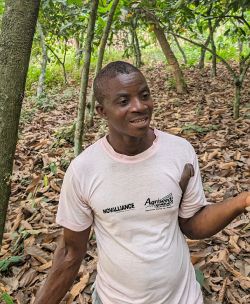
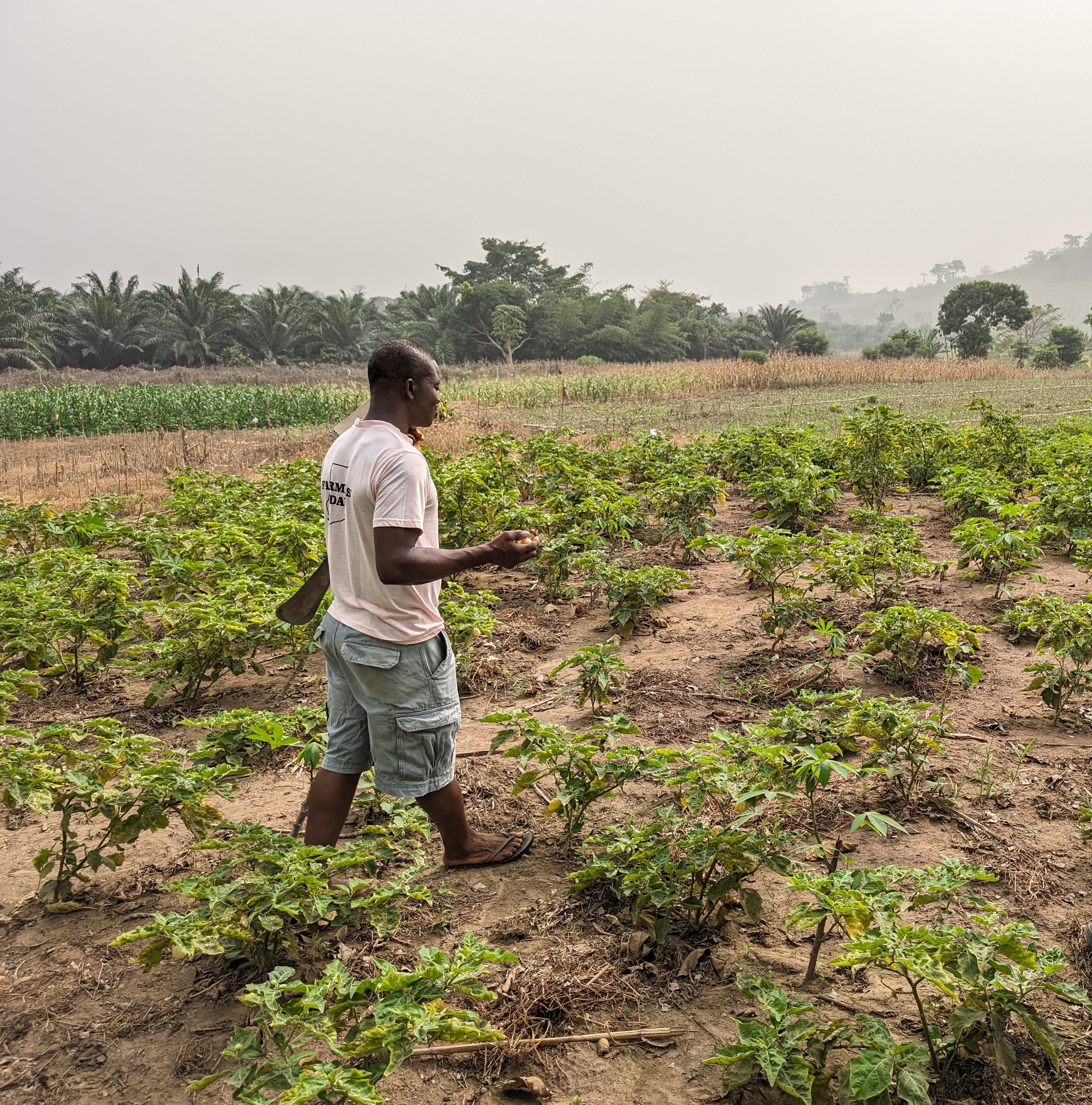
Francis Tei, a farmer in Otukwadjo, Ghana, cultivates his land according to the principles of agroecology. Here is the profile of his farm.
Context
- Name: Francis Tei.
- Location: Otukwadjo, Ghana.
- Installation date: 1991.
- Cultivated area: 3 ha.
- Soil texture: Sandy with large amounts of organic matter on the surface horizon.
- Number of people working on the farm: 2, but spread across 8 family members.
- Productions:
- Climate: In Nsawam, the rainy season is overcast, the dry season is partly cloudy, and the weather is very hot and oppressive throughout the year. Over the year, temperatures typically range from 23°C to 34°C and rarely drop below 22°C or rise above 36°C.
- Education/training/life path: Francis embarked on agriculture after being trained by his parents as well as through academic training and visits to farmers and peers. "From the start, I chose to be a farmer, which is why I studied agriculture in school and also attended agricultural training in Kumasi."
Motivations and goals
Francis has a strong interest in agroecology and is even part of the HGBF-Centre for no till. His goal is to develop pig and poultry farming, with about 300 heads.
Agronomic aspect
Crop production
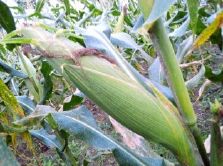
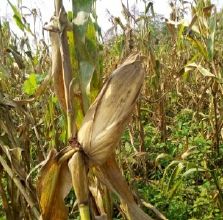
He practices this intercropping twice a year.
- Planting: Early March for the main season and late August for the secondary season.
- Fertilization: Two applications with Actyva 20%: 25kg for 30 x 60 m.
- Weeding: Once with a hoe, no chemical herbicide use.
- Insecticides: Against Poecilium, three applications before harvest.
- Yield:
- 2000-2500 plants for 72x72 feets.
- 12 "bucks" / acre (4050 m²), 16 bucks = 1 ton.
Marrow (Cucurbita Pepo) with velvet bean (Mucuna pruriens) as a preceding crop
- Velvet bean as a cover crop: 20 plants on 2000 m² for 3 months (end of February/beginning of March until May).
- Cover crop destruction with a roller.
- Planting marrows (a cucurbit related to cucumber) in May directly into the residues of cream mucuna.
Cassava
- Planting Panicum maximum (Guinea grass) in November as a cover crop.
- Cover crop destruction with herbicide.
- Planting cassava in April.
- 2 mango trees and 30 other trees in association.
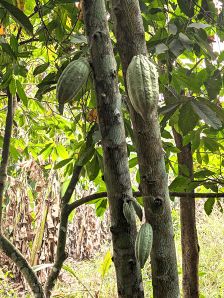
Cocoa
- Harvest: 1 ton/year.
Eggplants
- Area: 2 plots (2000 m²).
- Little profit on this crop and many issues with fall armyworm (Spodoptera frugiperda) attacks.
Coconuts
- Area: 2 hectares of plantation.
- Harvest: Year-round.
Animal Production
- Francis started a fish farming operation but is not yet selling.
- Goats: 300 Cedis / goat, 600 Cedis / year.
- Francis would like to start raising chickens.
Agricultural practices
Soil fertility management
- Reduction of chemical inputs to a minimum. Use of cover crops during intercropping and associated crops to maximize biomass production and reduce the use of chemical inputs (particularly nitrogen fertilization).
- Diversification of production (no monoculture on the plots) and agroforestry (cocoa, coconut). The only crop receiving mineral fertilization is maize, all other productions are sustained by fertilization from the destruction of cover crops and organic fertilizers (mainly pig slurry and manure).
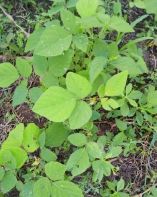
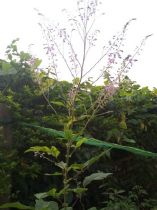
Pest management
- Fungicide treatment on maize.
- Use of insecticides only for maize against Poecilium, with 3 applications before harvest.
- To combat pests, Francis uses a cover crop called "push-push-push" : Desmodium tortuosum = Twisted sainfoin. This plant, when it reaches maturity, releases a certain aroma that insects and pests cannot tolerate, causing them to stay away.
- Cream mucuna is not attacked by insects mainly due to the heat it traps under its leaves. Its structure resembles an umbrella covering the ground, making the temperature underneath very high, which is inhospitable to pests. It also helps protect the soil from erosion and evaporation.
Soil tillage
Francis practices the Direct Seeding Mulch-based Croping (DSMC) for all his crops. He seldom resorts to soil tillage, even on the surface. Weeding is mostly done with a hoe.
Strategies to address constraints
- Water management: "For water management, we reduce the area of land we plant. For example, for maize, we plant only on half of the plot."
Reduction of planting density and plot size based on water availability.
- High labor requirements: Rental of a tractor for cover crop destruction with a roller and direct seeding.
Water System
- Source volume and flow: Borehole.
- Irrigation:
- 6 plots.
- 3 hours per plot.
- Twice a week.
- Total irrigation time: 36 hours per week.
- Too much time for irrigation, system is inefficient according to him.
Social aspect
Satisfactions / dissatisfactions
- Workload: 5, he works too much.
- Economic: 5, he spends too much on tractor rental and labor. With inflation on inputs and prices indexed to the dollar, costs are constantly increasing. Problems with eggplant diseases result in little profit from this crop.
- Work comfort: 9.
- Social: 8.
- Living environment: 8.
- Cooperation: 9, "I share my knowledge by teaching, and it helps the students a lot. I've had many visitors on the farm, and they have all been satisfied."
Scale from 1 = very dissatisfied, to 10 = very satisfied.
Economic aspect
Organization of work time:
- 2 full-time equivalents for a total of 8 people working on the farm.
- 1-2 months per year for 6 people.
Revenues
- Maize: 20000 Cedis for the main season. 1 buck = 400 - 1000 Cedis.
- 0.5 Cedis / fresh maize ear (cannot be stored for a long period).
- 1.5 Cedis / dry maize ear (can be stored for a long period).
Dry maize is three times more expensive because it can be stored in bags after harvest and sold to nearby poultry farms that come to collect it for feeding chickens. When farmers do not have sufficient storage facilities, maize is harvested fresh and sold directly at markets because it cannot be stored for long.
- Vegetables + okra: 10000 Cedis.
- Cassava: 5184 (72 x 72) plants = 2000 Cedis, 3-4 harvests per year = 8000 Cedis.
- Eggplants: 2 plots: 400 Cedis / year.
- Coconuts: On 2ha, he harvests 10-15 bucks per year (380 Cedis/buck) = 3800 - 5700 Cedis.
- Marrow (Pepo):
- 53 m² = 30000 Cedis (high season).
- -20000 Cedis for Canavalia seeds (1000kg of seeds, 1kg=20 Cedis)
- 10000 Cedis profitability.
- Cocoa:
- Harvest: 1 ton/year.
- 1300 Cedis / buck and he produces 16 bucks / year = 20800 Cedis.
Total revenue: 100,000 Cedis / year.
Costs
- Maize seeds: 820 Cedis/kg, purchase of 20kg of seeds = 16,000 Cedis.
- Cocoa:
- Harvest: 300 Cedis / buck.
- Pruning: 1000 Cedis / ha.
- Organic fertilization: 300 Cedis / L, 1L/ha.
- Tiller: 200 Cedis/ha, cocoa is not irrigated. Irrigation is only used for maize.
- Plantation: 1 acre = 450 trees, 1 tree = 55 Cedis, 1 plantain tree (intercropped): 3 Cedis.
- Insecticide against Poecilium: 25 Cedis per 200g sachet.
- Fertilizer: Activa: 25 kg = 240 Cedis for 75 days, 145 bags / acre, 28 bags per year.
- Fuel:
- Irrigation: 21 liters for 3 days (13 Cedis / liter).
- 5 full months of irrigation.
- 800 L per year = 10,400 Cedis.
- No machines other than the pump, so no additional fuel expenses.
Total costs: 30,000 Cedis / year.
Profits
70,000 Cedis / year.
Distribution channel
80% of the production is sold in Accra at the local market.
Farmer's advice
"You need to get inspired by others and also help other farmers learn how to work well."
Photo gallery
Sources
Interview with Francis Tei conducted in February 2024 by the team of Ver de Terre Production as part of the Urbane project. Photo credits: Francis Tei and Vincent Levavasseur.
This page was written in partnership with the Urbane project and with the financial support of the European Union.

